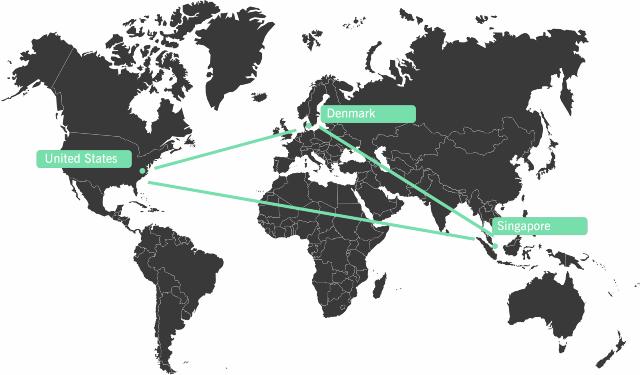International Cellular Agriculture Network (ICAN)
Accelerating the potential of cellular agriculture in modern food systems
This transcontinental network is cooperating to accelerate the development of cellular agriculture technologies by sharing knowledge, building new connections and creating a stronger basis for product development and commercialization of non-animal-based foods from cell cultures.
Joint efforts to intensify the development of cellular agriculture technologies
Cellular agriculture technologies are generally still early stage and currently only a handful of niche productions can supply cultured meat and precision fermented milk products to consumers in selected countries and still at a relatively high price.
.jpg&width=640&format=webp)
A lot of R&D is to be done for these technologies to become mainstream and overcome the challenges of cost, efficiency, scale up, taste and texture that make them largely unviable for large-scale production today.
Therefore, Food & Bio Cluster Denmark and Innovation Centre Denmark in Boston have organised an International Cellular Agriculture Network (ICAN) with leading researchers and ecosystem actors from The United States, Singapore and Denmark.
Cellular agriculture (CA) is the production of food products such as meat or dairy from cell cultures instead of from animals.
Through a series of networking activities, we will build connections, facilitate knowledge transfer and create the basis for transcontinental cooperation to accelerate the development and commercialization of cellular agriculture technologies. All with the purpose of speeding up development of these products and support commercialization.
Open network activities for non-members
- An innovation tour to the United States in late 2024 or early 2025
- Minimum two online workshops focusing cellular agriculture topics
- Exploration of potential cross-national collaboration such as research projects or commercial agreements
Funding
The Network is led by Food & Bio Cluster Denmark and financed by the Global Innovation Network Programme (GINP) under the Ministry of Higher Education and Science in Denmark.
If you are interested in tapping into the network, you are welcome to contact us.
Contact
DENMARK
DENMARK
UNITED STATES

Louise Krogh Johnson

Jeppe Falck

Torben Orla Nielsen

A transcontinental network

See network members
Why cellular agriculture?
The current food system relies on practices that are unsustainable with regards to land-use, water consumption, and biodiversity and a growing global population.
Approximately 40% of the total global protein supply comes from animal sources and the global livestock sector emits an estimated 7.1 GT of CO2-equivalent per year, representing 14.5% of human-induced GHG emissions. From a dietary perspective humans need mixed-protein diet, consisting of high-quality animal, dairy, and plant-based foods, but there is a dire need to diversify our food production and develop new technologies to provide us with the essential proteins we need. We need new biosolutions to alleviate the pressure on our planet.
Cellular agriculture (CA) is the production of animal-based foods from cell cultures rather than from animals.
After hunting and domesticating animals, cellular agriculture looks set to become the third phase of human sourcing of animal protein. Figures from the ReThinkX think tank suggest that lab-grown proteins may be five times cheaper than animal proteins by 2030.
While it may take longer than that, lab-grown proteins for beef replacement will potentially be up to 100 times more land efficient, 10-25 times more feedstock efficient, 20 times more time efficient, and 10 times more water efficient.


Webinar recordings:
Recording from 18 February 2025
ICAN Webinar about biomanufacturing infrastructure
Speakers:
- David Welch, Ph.D., Chief Scientific Officer and Co-Founder at Synthesis Capital
- Thierry Duvanel, Director of Innovation for the Buhler Group
Recording
ICAN Webinar about Biomass Fermentation
Speakers:
- “Microalgae for food, feed, biofuels, and biomaterials” By Dr Nikola Medic, Danish Technological Institute
- “Circular Bioeconomy approaches in microalgae cultivation: Maximising value from food side streams” by Dr Alcine Chan, National University of Singapore
Recording from 26 November 2024
ICAN Webinar about Cell Lines and Culture Media for Cultivated Meat Applications
Speakers:
- “Putting the cells in cell-based meat: obtaining and optimizing cell lines for cultivated meat applications” by Dr. Andrew Stout, Tufts University
- “Media for cultivated meat: challenges and opportunities” by Dr. Martin Krøyer Rasmussen, Aarhus University
Recording from 28 October 2024
ICAN Webinar about biomanufacturing
Speakers:
- “Manufacturing with precision fermentation technology”m Rasmus Rune Hansen, 21st.BIO
- “Biomanufacturing Infrastructure Needs”, Kelly Smith, Kalmia Consulting / Sable Fermentation
- Moderator: Matthew McNulty, Tufts University Center for Cellular Agriculture









